Philodendron White Knight is an exotic, stunning hybrid sought-out houseplant. Plant enthusiasts love adding white knight to their collection due to its shiny variegated, heart-shaped foliage. It is also part of the “Tripple crown,” including Philodendron White Wizard and Philodendron White princess – a name given by plant collectors to these three Philodendrons because they are highly similar but with little variation in colors of petioles and stems.

Philodendron White Knight gained popularity for its stunning variegated foliage; however, it is also available in little to no variegation. But, the glossy white half-moon heart-shaped leaves are adored by rare plant collectors. Interestingly it is hard to find but easy to care for Philodendron.
Closely-Related Allied Species: Philodendron White Princess, Philodendron White Wizard, Philodendron Florida Ghost, Philodendron Verrucosum, Philodendron Rugosum, Philodendron Gloriosum, Philodendron Spiritus Sancti , Philodendron Moonlight.
Related Products:
Origin And Family
The Philodendron White Knight plant is a drop-dead gorgeous tropical plant that originated in the rainforests of South America. The Philodendron White Knight plant, also known as White Knight Philodendron, is a hybrid cultivar of the Araceae family Genus Philodendron.
| Botanical Name: | Philodendron White Knight |
| Family Name: | Araceae |
| Other names: | White Knight Philodendron |
| Plant Type: | Foliage, vine, perennial |
| Origin: | South America |
| Color: | green, white, and burgundy variegation |
| Height: | Avg. Up to 4 Feet |
| Humidity: | High humidity (70-80%) |
| Temperature: | 60°F – 80°F |
| Light Need | Bright, indirect light |
| Status | Rare |
| Hardiness Zones | 9a, 9b, 10a, 10b, 11a, 11b |
| Preferred pH | 5.0-7.0 |
| Soil type | Well-drained organic soil |
Philodendron White Knight Variations
Interestingly, the White knight exhibits variation in colour and size of the leaves. You may notice some White Knight leaves differ from others, but they all are sold as White Knight. Some White Knights are very expensive, and there is a reason for that which makes them special and rare. There are few variations of White Knight; few come with little to no variegation, minty white to whole white leaves, and few exhibit only dark green leaves with maroon or burgundy patches in the leaves. But they all have a burgundy stem and petiole with white petiolar sheaths.
It is important to know that variegated White Knight is expensive, ranging from $100 for stem cuttings to $1000 for a more mature plant and is hard to find. Therefore, always confirm with the seller about the variegation because plain White Knights would cost a few bucks.
Philodendron Royal Court or Triple Crown:
If you are a plant collector, you might know that the Philodendron collection is not complete without the royal court threesome of a white knight, White wizard and White Princess. These three stunning plants are astonishingly similar, and a common person won’t be able to tell the difference. This highly sought-after philodendron trio may differ in the colour of stems and petioles. However, we will list some differences between these remarkably stunning plants for our readers that would help them if they buy one.
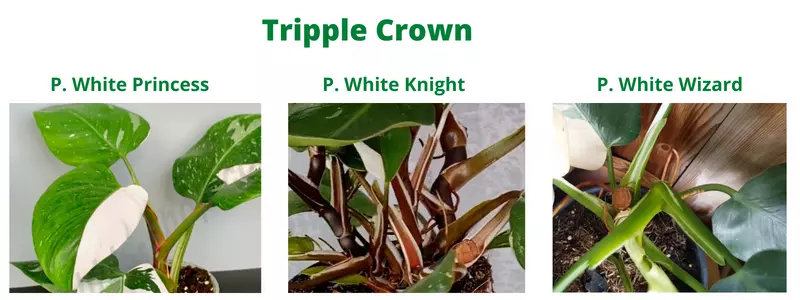
What is the difference between Philodendron White Knight and White Princess?
The Philodendron White Wizard and White Knight have broad leaves compared to the White Princess’ narrow foliage. White Princess exhibits green stem, whereas White Knight exhibits burgundy or reddish stem. You can also differentiate the White Princess from the other two white Philodendrons by her structure. Moreover, White Princes have pink or red along the green petiolar sheaths.
On the other hand, White Knight has reddish brown petiole with white petiolar sheaths similar to Pink Princess. White Princess’s leaves are narrow and long, similar to Pink Princess, whereas White Knight exhibits round, heart-shaped leaves with patches of white variegation plus whole white leaves.
White Wizard Vs White Knight
Usually, White Wizard, Knight and Princess are called a Triple Crown set by plant collectors. White Wizard has the largest and roundest variegated leaves. While Wizard has green stems with white lines and is faster growing with bigger leaves than White Knight.
However, White knight features reddish-brown stems and petioles with white variegation. Some White knight also exhibits trio colour leaves – white, green and little red patches. Moreover, White Wizard and Knight are climbers and produce strong aerial roots to cling to moss poles for faster growth.
How do you take care of a Philodendron White Knight?
Despite its high price tag, Philodendron White Knight is an easy-to-care-for plant that thrives in a tropical environment and can be grown indoors and outdoors. In this guide, we will cover the complete care of Philodendron White Knight and how to save it from reverting. There are a few tips and tricks to maintain and maximise the stunning white variegation on the leaves.

Adding White Knight to your Houseplants
Before introducing it to your other collection, it is essential to ensure that your new plant is free of pests or any disease. Sometimes, plant parents overlook this and may end up infecting many plants in their collection. Please keep your new White Knight away from all other plants for around two weeks and inspect the leaves and stem for any sign of pest or disease.
Moreover, you can also shower the leaves thoroughly to make sure it’s pest free. After quarantine, you can place the White Knight with all the other plants in your collection.
Support:
White Knight Philodendron is a climber and needs good support to cling onto something. As this is a vine, you may notice as it keeps growing stem at the very bottom, which is holding everything up, is less thick than the thickness of the stem at the top. It also causes the top part of the vine to be heavy and susceptible to snapping. Therefore, we recommend using a moss pole or support sticks to climb onto and grow to its full potential. Like Philodendron Verrucosum, White Knight tends to grow faster and bigger leaves if provided any support.
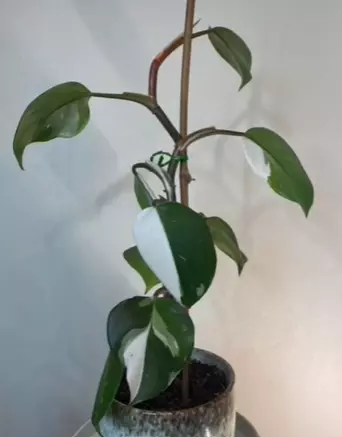
If you are planning to plant it out side , choose a place near a tree to which it can climb onto. It would support the plant and White Knight will have large , rounder leaves.

Philodendron White Knight Growth
Philodendron White Knight plant is a member of the Philodendron genus, native to South America. Like many Philodendrons, this evergreen and the tropical plant is a climber and can grow up to 10 to 12 feet tall under favourable conditions. It is moderate grower and can grow one or two leaves per month. In summer the growth is relatively more than in winter.
This variegated cultivar usually has bicolour leaves (green with white markings) and whole white leaves. It features round heart-shaped leaves exhibiting stretches and patches of white colour. It also grows whole white or half moon leaves when placed in bright indirect light. The colour of the leaves is light green, which darkens as they mature. Moreover, brighter light increases the chance of variegation. White Knight exhibits burgundy or reddish stem and petiole with white petiolar sheaths.
Is Philodendron White Knight a Climber?
Philodendron White Knight is a climber and usually grows up to a few feet( usually 3 to 4 feet) in a container. It is a moderate grower and grows faster when mounted with a moss pole. We recommend using a moss pole for White Knight if you want bigger leaves and more height.

Light Requirement
Firstly, providing your White Knight Philodendron with enough light is the most critical factor influencing the amount of variegation it will have, including the stunning whole white leaves. P. White knight thrives in bright indirect sunlight. Therefore, choose a spot or window where it can receive bright indirect light for 6 to 8 hours a day. Don’t expose your White Knight to direct sunlight, even the morning sun rays, as the white variegation is highly sensitive to direct sun rays and may burn, resulting in brown leaves. We suggest placing this plant in an east-facing or a north-facing to have enough bright light .
If you do not have a bright location at your place, you might consider buying a grow light for this plant to produce beautiful white and green variegated leaves. Without enough light, the White Knight will begin reverting to green, losing its stunning white variegation. In addition, it’s tough to encourage this plant to regain its beautiful white variegated leaves once reverted. If it happens, you need to be patient and may need to chop the green leaves cuttings until it starts growing the variegated leaves again.
How much is Bright, Indirect Light required for P. White Knight?
If you are a beginner or not sure what bright, indirect light means precisely; you might need to use a light meter to measure the overall light intensity in a room. It can also measure both Lux and FC (foot Candle) and the light from grow lights. We recommend 200-400FC (foot candles) for White knight if you want stunning variegated leaves.

Water Requirement
The philodendron white knight prefers a moist medium; therefore, we recommend watering it just on the cusp between moist and dry. Bear in mind, the watering frequency of any plant depends on several factors such as weather, temperature, humidity, and light intensity. Therefore, the watering once-a-week rule may not apply to all plants.
We recommend using a moisture meter to monitor the soil dryness before watering. Moreover, you can check the soil using your fingers. Water the White Knight once the soil’s top two to three inches is dried. You can also plunge a chopstick or wooden stick into the soil and leave it for a few minutes. Later take out the chopstick from the soil. If the soil is damp, the wooden stick will turn dark-colored and have soil around it. If the chopstick doesn’t get wet and change its color, it means the soil is dry, and your White knight needs watering.
On average, you may need to water once or twice a week in the spring and summer when the plant is more active. You need to thoroughly water the plant until the excess water drains out through the drainage holes. Always use distilled water to avoid browning of plant tips. A self-watering planter is also a practical option for this kind of plant, where plant roots absorb water as needed.
Over Watering Problems
White Knight Philodendron is an Aroid that doesn’t like to sit in damp soil. Overwatering the plant may cause root rot or fungal diseases, resulting in yellowing leaves, and eventually may die. Moreover, the leaves may droop if the soil dries completely between watering. We recommend watering the plant when the soil is 80% to 90% dry but moist.

Potting & Soil Requirement
Philodendron White Knight is an Aroid that enjoys well-draining soil. We recommend planting your White knight in a terracotta pot or a transparent plastic pot with good drainage holes. Please don’t plant it in a large pot as the roots won’t be able to get air and may get root rot. The best size for this plant would be to choose a pot one or two inches bigger than the root ball of the plant.
P. White Knight thrives best in well-draining, chunky and moist soil high in organic matter. The roots must get aeration for the White knight to grow. The regular potting mix is too dense for Aroids and may cause root rot or other fungal diseases.
You can use any good aroid potting mix or can make your potting mix by mixing the following ingredients;
This potting mix lets the excess water drains out, and there will be proper oxygen for the root aeration.
The White knight prefers neutral to acidic soil of pH around 5.0-7.0, meaning White Knight likes neutral to acidic soil. If you want to ensure the pH of the soil, you can use Rapitest Test Kit for Soil pH.

Repotting
Philodendron White Knight doesn’t need frequent repotting. You may need to repot it around every two years. You would be looking for a few signs to determine if it needs repotting. If the plant shows slow growth, check the roots. If the roots come out of the drainage holes, the plant is root bound and needs repotting.
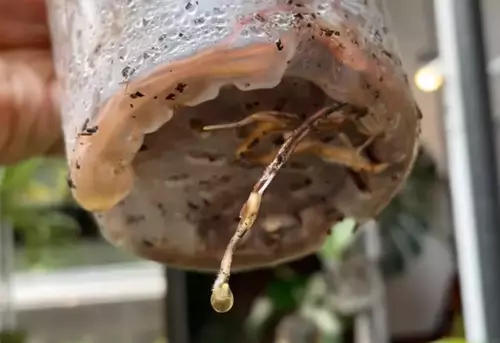
Follow the step-by-step guide to repot the Philodendron White Knight ;

Humidity and Temperature
The philodendron white knight is a tropical houseplant that loves humidity and warmth. This hardy plant can tolerate typical household humidity and temperature but would thrive in places with temperatures between 65°F-80°F( 18°-26°C) during the day. White Knight can endure a slight drop in temperature during the night, but below 55° F (12°C) will have stunted growth. During winter, keep the plants away from frosted windows. The white variegation is also sensitive to high temperatures and may burn.
The Philodendron White Knight happily enjoys a humid environment as a tropical plant. Humidity levels above 60% to 70 % are ideal for this plant.
Extreme temperature changes around the A.C vents, windows, and doors can stress your plant. You can use a hygrometer to check the temperature and humidity to ensure better care.
Here are some easy tips to keep the humidity higher in your house

Fertilizer
Since Philodendron White Knight is grown for foliage, any good Nitrogen-based fertilizer would encourage foliage growth. We recommend feeding the plant during the growing season( spring and summer). The rule of thumb is to dilute any liquid fertilizer, feed your plant with half the recommended amount, and see its effect on the plant. Gradually increase the amount to avoid any foliage or root burn.
You can also use any slow-release fertilizer for the White knight. If you’re looking for more natural fertilizer, you can fertilize White Knight with liquid Dirt( which worked for me). Fertilize your plant once a month during Spring and Summer when the plant’s growth is active. You can stop fertilizing your plant in the early fall as it enters its dormant period.
Moreover, some plant parents also practice fertilizing their houseplants every time they water. In this case, reduce fertilizer by a quarter of the original recommended amount.

How do Philodendron White Knights Propagate?
Like most Philodendrons, the White Knight can easily be propagated by stem cuttings and air-layering methods. Since it’s a climber with a single stem and multiple petioles, you will get the top cutting for propagation.
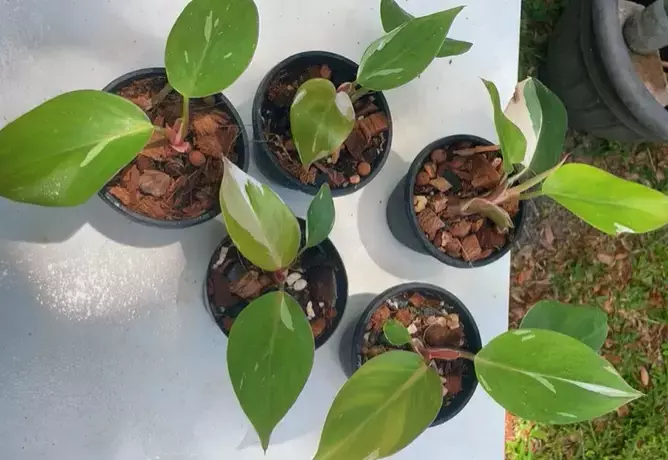
The propagation will give you a new plant and may lead to a bushier plant. Moreover, propagation is the most effective and successful solution to encourage variegation (especially if the leaves start reverting).
Here’s a step-by-step guide on how you can propagate White Knight Philodendron by stem cuttings;

Water Propagation:
If your cutting has minimal areal roots, we suggest using water propagation. Take a clean jar or plant propagation station and fill it with distilled water. Place the cutting in the jar, dipping the node and areal roots into the water. You may notice roots sprout from the growth point within 2-3 weeks. Once the roots grow at least up to one inch, you can plant the cutting into aroid potting mix or sphagnum. Keep in mind that water propagation is a relatively slow method for Philodendrons.
PON or LECA Propaagtion:
If you want to avoid any chance of root rot, you can plant your cutting into PON or LECA mediums.
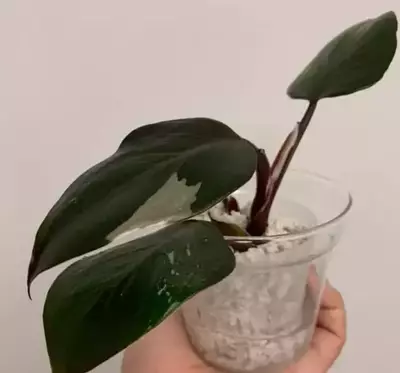
Take a transparent pot and fill 3/4 of the pot with PON or LECA. You can put the PON or LECA medium pot in a self-watering planter or water it manually. Place the cutting into the PON or LECA and place the point in a spot with high humidity and bright indirect sunlight. You can monitor the root growth through the transparent pot, and once you notice enough root growth, you can repot it into an aroid potting mix and a bigger pot.
Propagating Stem Cuttings in Sphagnum Moss
Propagation of stem cutting in sphagnum moss is faster than any other method. You can take a clean small pot and fill it with moist sphagnum moss. Preferably choose a transparent plant pot with a humidity dome if the cutting is small and can fit into the pot. Plant the cutting into sphagnum moss, ensuring the node is completely covered with moss. Cover the pot with a humidity dome to provide high humidity and place it in a warm, bright area. Mist the moss to keep it moist. The moss should not be damp; else it will cause the rotting of the stem cutting. Within a couple of weeks, the cutting will root out and be ready to plant into the potting mix.
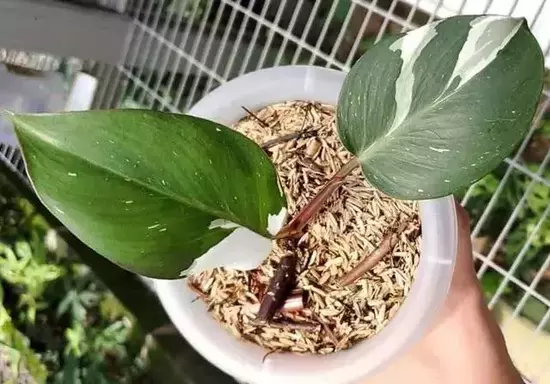
The key to propagating with sphagnum moss is to keep it always moist.
Air Layering Method:
Air layering is a relatively less popular propagation method for White Knight. This method chooses a node on the stem where you want to cut your plant. Wrap the node with moist sphagnum moss and cover the moss with a plastic sheet.
You can also use air layering pods to cover the sphagnum moss. Once you notice enough root growth from the node, take a sterilized pair of shear and cut the stem, including the node with new roots. This way, the cutting already has grown enough roots and can be potted directly into a well-draining aroid potting mix.

Should You Prune Philodendron White Knight?
As Philodendron White Knight grows, the top part of the stem may grow thicker than the bottom stem, resulting in the top part being heavy. The plant becomes susceptible to snapping; therefore, pruning the top portion saves the plant from tipping over or snapping.
Moreover, pruning will give you a stem cutting which you can propagate to get a new plant or pot it with the mother plant to make it bushier. If you find any yellowing or dying leaf on White Knight, prune it with a sterilized shear or a pair of scissors.

Is The Philodendron White Knight Plant Toxic?
Unfortunately, most Philodendrons are toxic and not pet friendly. The Philodendron White Knight’s leaves contain a toxin called calcium oxalate. If consumed by pets or humans, it can cause a loss of apatite, burning sensation and swelling of the lips, mouth, throat ,and tongue. Therefore we recommend keeping this plant away from children and pets who may accidentally chew this toxin beauty.

Common Problems
Pest control
The pests I’ve seen on this plant are the occasional spider mite, Aphids, and mealy bugs. This plant got all the nooks and crannies, and they’ve got the sheath, so it does get some mealy bugs. To treat mealybugs, take a cotton swab dipped in 70% isopropyl alcohol and swipe it directly on the pests.
Aphids sucks the saps and weaken the plant causing black and brown patches on the White Knight petioles. You can treat an aphid infestation manually by removing the bugs. Insecticidal soaps and oils can be used to kill the Aphids on the plant. Moreover, pruning the infested part of the plant is also effective in spreading the Aphids.
To get rid of spider mites, spray the infested plant with neem oil or take a cloth, dampen it with Neem oil, and apply it to the affected parts. Showering the plant leaves with a water hose also helps eliminate spider mites.
There are a lot of pests that won’t go on it, but at least in my experience, they haven’t proliferated quickly. You can refer to our pest control guide on pest control and check out the symptoms of different pests and treat them accordingly.
Common Problems With Philodendron White Knight
With the proper care, White Knights are relatively problem-free and easy to take care of houseplants. Some of the common issues that this plant may face are;
Browning Edges and Leaves
Browning edges of the White knight’s leaves are usually a result of a lack of humidity. Unfortunately, you cannot reverse the damaged brown leaves back to green. You can increase the humidity by using a humidifier to prevent further browning of edges.
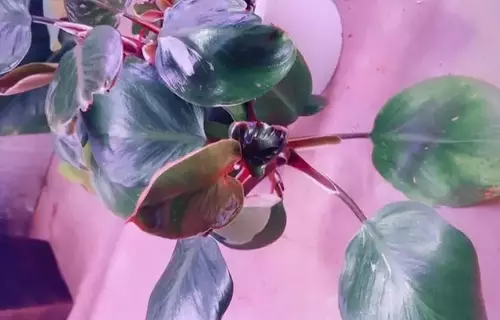
The high light intensity can cause the browning of the white variegation of the leaves even before unfurling. The delicate white patches and portions on the leaves are prone to burning under harsh lighting, resulting in large burnt spots. We recommend moving the plant away from a high-intensity light spot to save the variegation.
Root Rot
Root rot is a very common problem in Philodendron that may occur due to poor soil drainage. The simplest way to avoid root rot in White Knight is not to let this plant sit in damp soil. Keep the soil moist and let excess water runs out. Use the pots with suitable drainage holes to provide aeration to the roots.
FAQs
Can Philodendron White Knight Revert?
Yes, Philodendron White Knight can revert easily if not getting enough bright light. Leaving the plant in less bright spot results in the white variegation reverting to green. Moreover, if the plant stays in less light for two to three months, it will completely lose its variegation and turn green. The white potion of the leaves doesn’t have chlorophyll and cannot photosynthesize. Less chlorophyll means less plant energy. When plants don’t get bright light, the plant grows green leaves to produce plant food. Hence, to prevent your White Knight from reverting, keep it in a bright light spot.
How do I get my reverted variegation back?
Once a White Knight reverts to green, it is hard to get the variegation back. You can try a couple of things to get the variegation back. We suggest pruning away any green leaves that appear to encourage the variegated growth. Or cut the stem till the point the plant has variegated leaves and petioles and continue doing it until you get variegated new growth. You can increase the light intensity from 250 CF to 350 CF or keep the plant in bright light for twelve hours daily.
Is Philodendron White Knight rare?
Philodendron ‘White Knight’ is a somewhat rare and desired tropical houseplant that is not widely available. It has beautiful red stems with white variegation, while the leaves are variegated in bright white to varying degrees. The plant tends to have stunning full and half moon leaves. Such variegated White Knight is hard to find and costs you a fortune. White Knights with little to no variegtion are cheap and can be found easily, but they tend to revert in a few months.
Is Philodendron White Knight a hybrid?
The philodendron white knight is a hybrid houseplant featuring stunning variegated white, green, and sometimes trio-colored leaves( green, white, red).
How do you increase variegation in White Knight?
The most effective way of increasing the variegation in White Knight is to keep it in bright indirect light or under grow lights. Moreover, cutting the stem with new non-variegated leaves till the last variegated leaf also encourages variegation.
Related Posts
Philodendron Melanochrysum Care & Growing Guide
The Philodendron Melanochrysum, a majestic symphony of nature, also known as the ‘Black Gold Philodendron,’ the botanical gem is a captivating pageantry of lush hues and rich textures, emanating a unique blend of elegance and resilience from the tropical heartlands…
Philodendron Burle Marx Care & Propagation Guide
Philodendron Burle Marx holds a unique and distinguished position in the world of houseplants. The most notable feature of the Philodendron Burle Marx is its large, glossy leaves, which come in heart-shaped or arrow-shaped variations. These leaves are adorned with…
Philodendron Scandens-“Sweetheart Plant” Easy Care Tips
Philodendron Scandens, often called the “Heartleaf Philodendron” or the “Sweetheart Plant” earns its evocative namesake through its captivating physical attributes. This perennial vine exhibits heart-shaped leaves that dangle delicately from slender and wiry stems. These leaves, adorned in glossy shades…
Philodendron Erubescens ‘Imperial Red’ Care Tips
The Philodendron Imperial Red, a botanical marvel, epitomizes the perfect fusion of elegance and vibrancy. Botanically known as Philodendron Erubescens, this plant traces its origins to South America’s lush and verdant tropical rainforests. Its exquisite appearance is characterized by lush…
Philodendron Ring of Fire Care & Growing Tips
Unleashing a maelstrom of botanical charm, the Philodendron Ring of Fire stands resplendently as a masterpiece of nature’s artistry, weaving together the vibrancy of hues and the allure of unusual form in an intimate dance of unparalleled allure. Philodendron Ring…

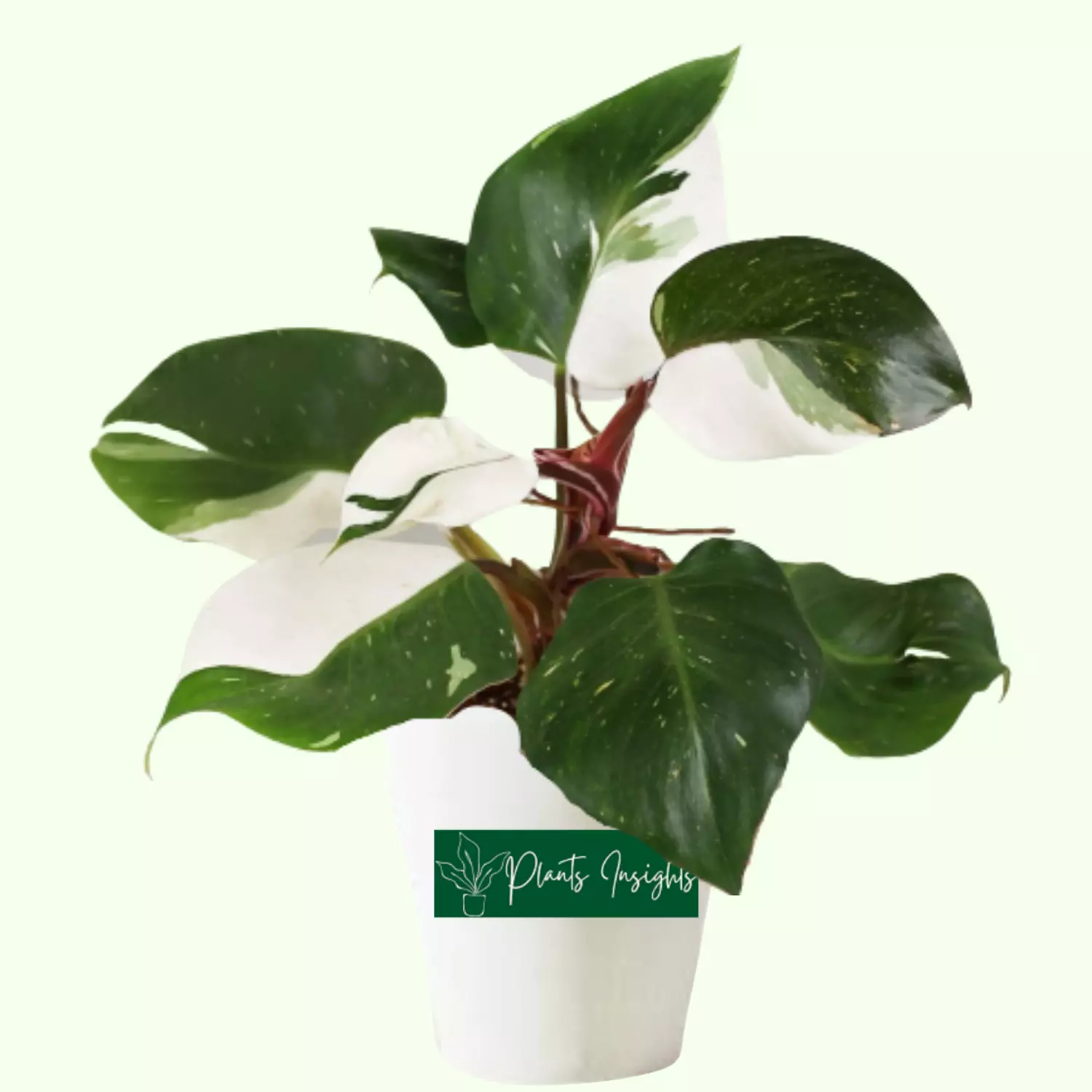
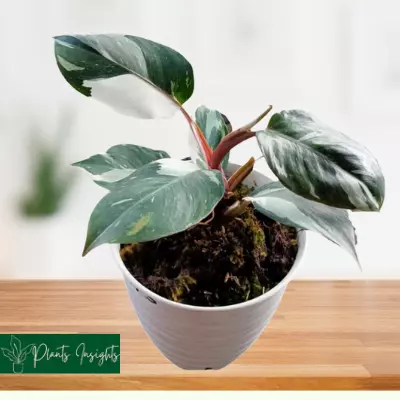


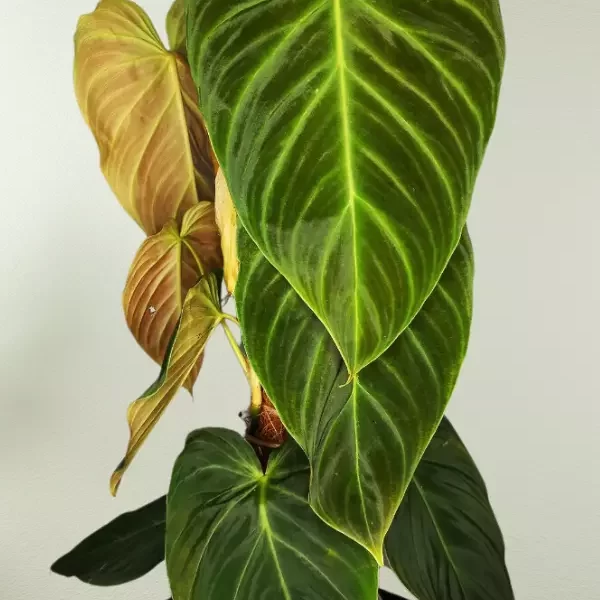
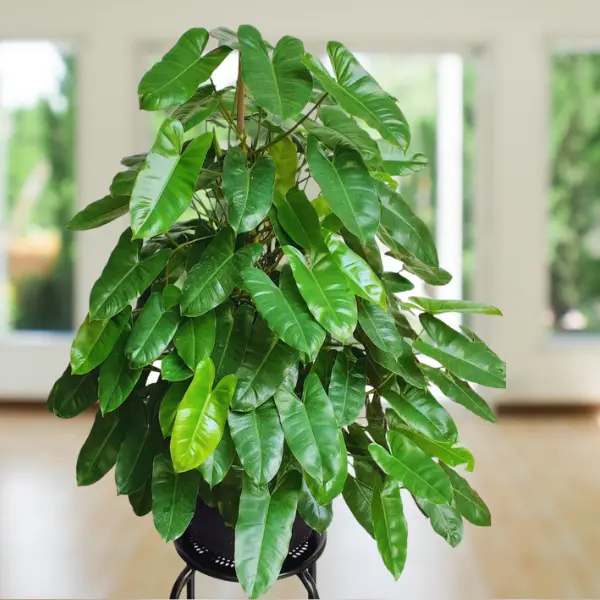
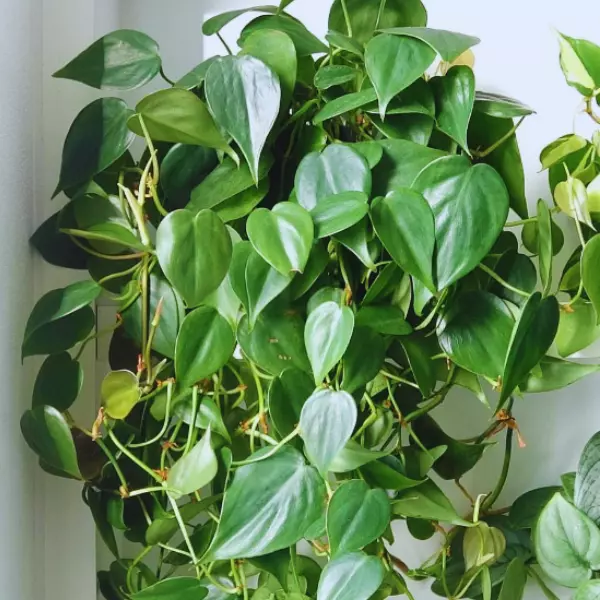
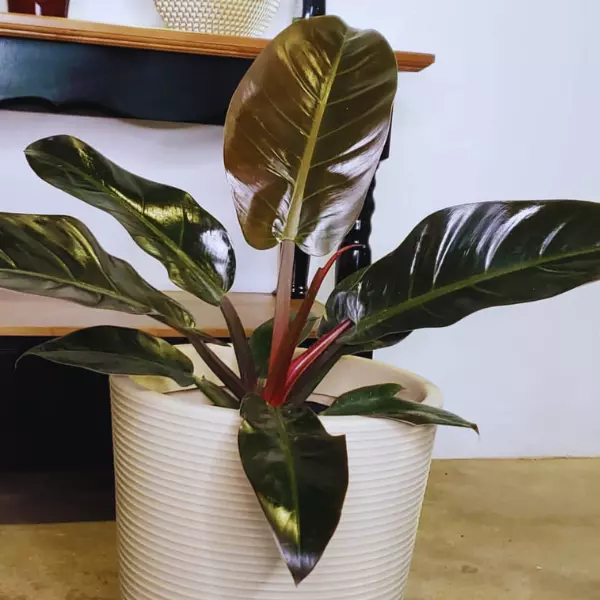
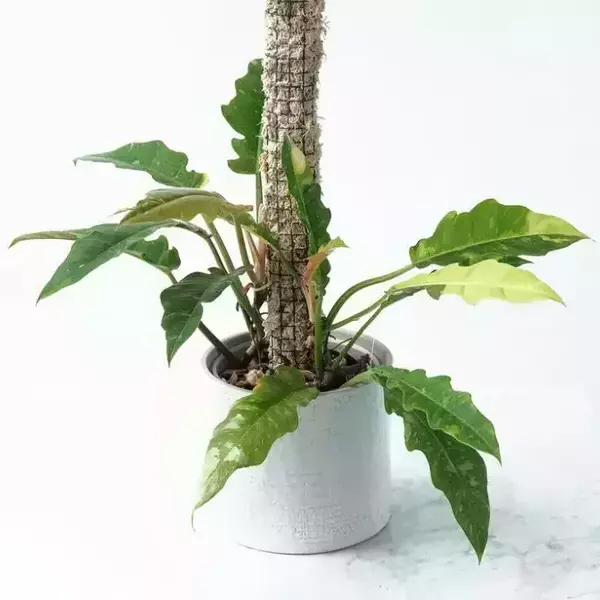
I?¦ve recently started a site, the information you provide on this website has helped me tremendously. Thanks for all of your time & work.